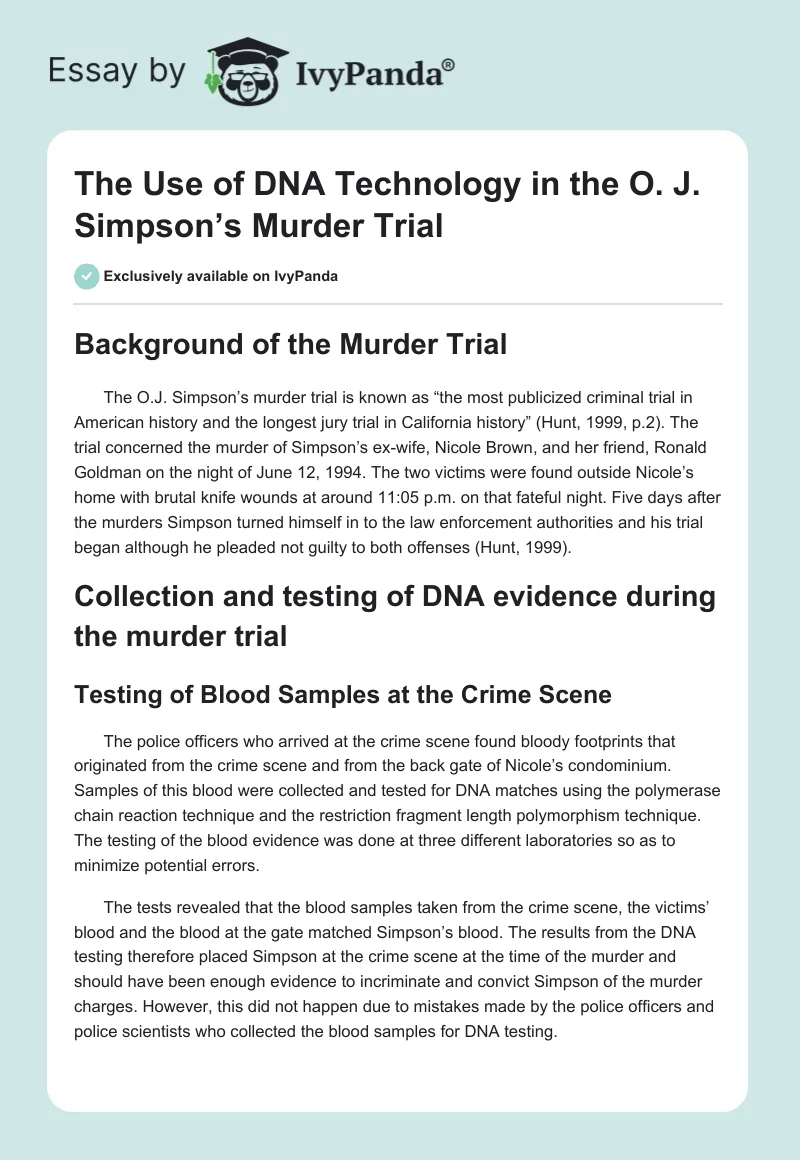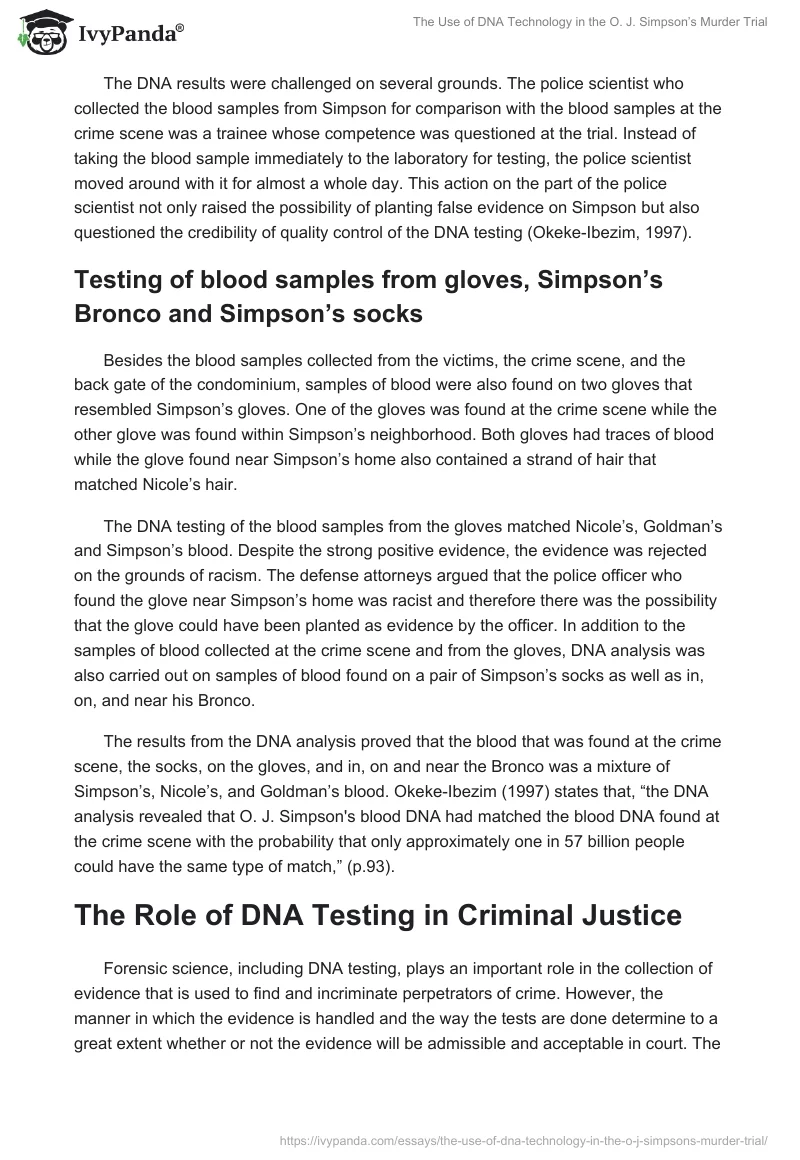Background of the Murder Trial
The O.J. Simpson’s murder trial is known as “the most publicized criminal trial in American history and the longest jury trial in California history” (Hunt, 1999, p.2). The trial concerned the murder of Simpson’s ex-wife, Nicole Brown, and her friend, Ronald Goldman on the night of June 12, 1994. The two victims were found outside Nicole’s home with brutal knife wounds at around 11:05 p.m. on that fateful night. Five days after the murders Simpson turned himself in to the law enforcement authorities and his trial began although he pleaded not guilty to both offenses (Hunt, 1999).
Collection and testing of DNA evidence during the murder trial
Testing of Blood Samples at the Crime Scene
The police officers who arrived at the crime scene found bloody footprints that originated from the crime scene and from the back gate of Nicole’s condominium. Samples of this blood were collected and tested for DNA matches using the polymerase chain reaction technique and the restriction fragment length polymorphism technique. The testing of the blood evidence was done at three different laboratories so as to minimize potential errors.
The tests revealed that the blood samples taken from the crime scene, the victims’ blood and the blood at the gate matched Simpson’s blood. The results from the DNA testing therefore placed Simpson at the crime scene at the time of the murder and should have been enough evidence to incriminate and convict Simpson of the murder charges. However, this did not happen due to mistakes made by the police officers and police scientists who collected the blood samples for DNA testing.
The DNA results were challenged on several grounds. The police scientist who collected the blood samples from Simpson for comparison with the blood samples at the crime scene was a trainee whose competence was questioned at the trial. Instead of taking the blood sample immediately to the laboratory for testing, the police scientist moved around with it for almost a whole day. This action on the part of the police scientist not only raised the possibility of planting false evidence on Simpson but also questioned the credibility of quality control of the DNA testing (Okeke-Ibezim, 1997).
Testing of blood samples from gloves, Simpson’s Bronco and Simpson’s socks
Besides the blood samples collected from the victims, the crime scene, and the back gate of the condominium, samples of blood were also found on two gloves that resembled Simpson’s gloves. One of the gloves was found at the crime scene while the other glove was found within Simpson’s neighborhood. Both gloves had traces of blood while the glove found near Simpson’s home also contained a strand of hair that matched Nicole’s hair.
The DNA testing of the blood samples from the gloves matched Nicole’s, Goldman’s and Simpson’s blood. Despite the strong positive evidence, the evidence was rejected on the grounds of racism. The defense attorneys argued that the police officer who found the glove near Simpson’s home was racist and therefore there was the possibility that the glove could have been planted as evidence by the officer. In addition to the samples of blood collected at the crime scene and from the gloves, DNA analysis was also carried out on samples of blood found on a pair of Simpson’s socks as well as in, on, and near his Bronco.
The results from the DNA analysis proved that the blood that was found at the crime scene, the socks, on the gloves, and in, on and near the Bronco was a mixture of Simpson’s, Nicole’s, and Goldman’s blood. Okeke-Ibezim (1997) states that, “the DNA analysis revealed that O. J. Simpson’s blood DNA had matched the blood DNA found at the crime scene with the probability that only approximately one in 57 billion people could have the same type of match,” (p.93).
The Role of DNA Testing in Criminal Justice
Forensic science, including DNA testing, plays an important role in the collection of evidence that is used to find and incriminate perpetrators of crime. However, the manner in which the evidence is handled and the way the tests are done determine to a great extent whether or not the evidence will be admissible and acceptable in court. The case of O.J. Simpson is one classic illustration of the importance of proper handling and investigation of evidence.
Even though all results from the DNA tests pointed to Simpson as the actual perpetrator of the crimes, Simpson was found not guilty simply because of improper handling of the evidence by the officers and investigators. The case also illustrates that even in cases where the most alarming evidence is produced by forensic scientists there is a need to convince the jury beyond all reasonable doubt that the accused is indeed guilty (Butler, 2001).
Recommendation
High-quality forensic science should go hand in hand with quality crime scene collection of evidence. It is therefore important for law enforcement departments to train their officers on how to best approach crime scene investigations and how to handle the collected evidence in the most appropriate manner. This will increase the chances of rightfully convicting criminals and serving justice to all the parties involved in a crime (Abbott and Batt, 1999).
Reference List
Abbott, W., and Batt, J. (1999). A handbook of jury research. New York: ALI-ABA.
Butler, J.M. (2001). Forensic DNA typing: biology and technology behind STR markers. New York: Academic Press.
Hunt, D.M. (1999). O.J. Simpson facts and fictions. Cambridge: Cambridge University Press.
Okeke-Ibezim, Felicia. (1997). O.J. Simpson: The trial of the century. New York: CSHL Press.


